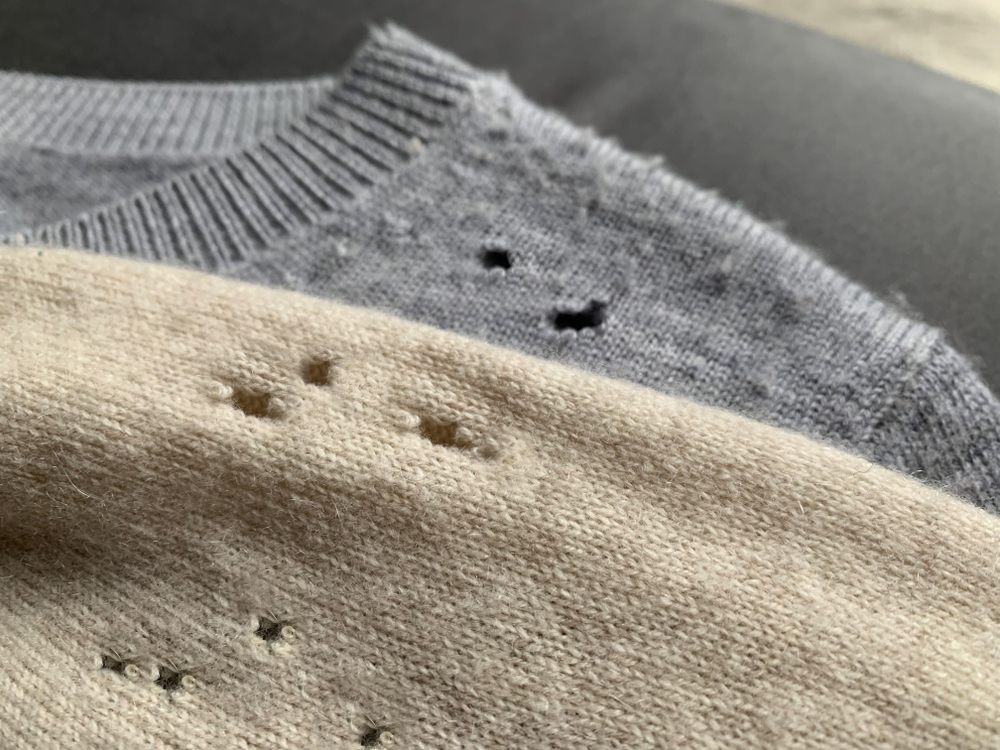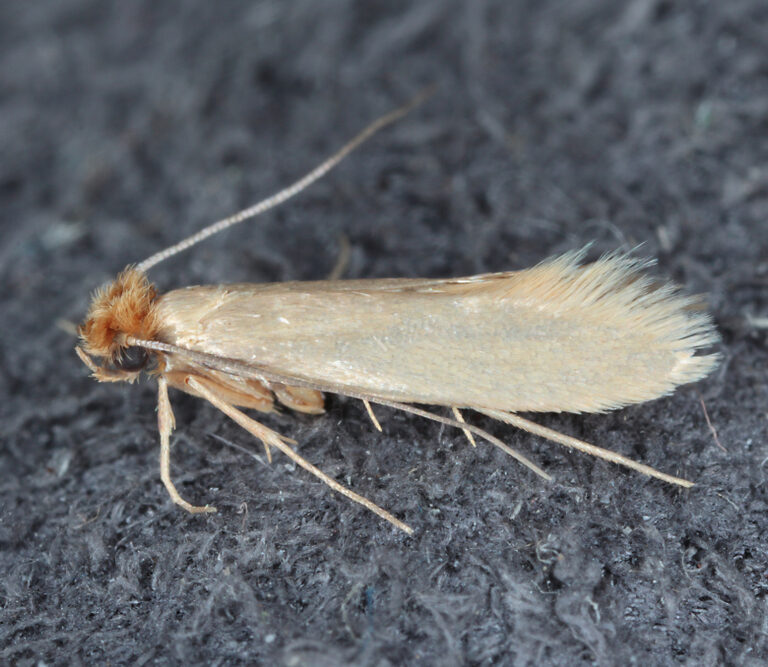There’s nothing more fun than taking a trip down memory lane by taking all your clothes out of the closet and seeing what you have on hand to wear. Hey, there’s those old jeans with the holes in them! And your favorite t-shirt, with all the holes in it! Oh, and this sweater, with all the holes…wait a second.
These aren’t fashionable clothes at all — you simply have a moth problem. The little creeps have been feasting on your threads for weeks, ruining countless articles of clothing.
Is this really happening? Could it have been prevented? Is God punishing you? Is there anything you can do about it?
The answers to those questions, in order, are yes, yes, maybe, and yes again. Luckily, we’re going to show you how to solve the problem below.
How Did Moths Get in Your Closet in the First Place?
One of the first things many people want to know when they discover they have a clothing moth problem is how the little jerks got in their house in the first place. After all, if you don’t know how they got in, you can’t stop more from entering — and you may be leaving yourself vulnerable to other bug infestations as well.
Unfortunately, it’s difficult to answer with any certainty how the moths got in your house, but there are a few usual suspects that you should consider.
Torn Screens
If you have screen doors in your home, you should examine them closely. If there are any tears or rips in the fabric, moths (and other bugs) will view it as an engraved invitation.
To stop those creepy-crawlies from sneaking in, you’ll need to either fix the screen or, if you have a solid door behind the screen, always keep it closed. Also, avoid turning on any lights near the screen door at night.
Cracks in Doors and Walls
When you close an exterior door, can you still see light peeking through? If so, there’s plenty of room for bugs to get in as well.
You should take the time to inspect your home for cracks and crevices that might allow insects to wriggle inside. If you find any, fill in the gaps with insulation, caulk, or filler so that there’s no more room for moths and other undesirables to get in.
Not only will this stop bugs from getting into your house, but it will also lower your heating bills — talk about a win/win.
Thrift Shop Purchases
We know what you’re thinking — you’d definitely notice a moth on your new-to-you clothes before you brought them home, right? The fact of the matter is, it’s not moths that eat your clothes — it’s their larvae, which are almost impossible to see with the naked eye.
Moth larvae can be transported into your home from thrift store purchases, clothing bought at garage sales, and even furniture you’ve bought second-hand (especially if you just picked it up off the curb).
If you’re stumped as to how moths could have gotten into your closet, going back over recent purchases is a good place to look. Also, wash anything you buy second hand in hot water before you put it in your closet, just in case.
How to Stop Moths From Eating Your Clothes

Now that you have some idea of how the moths got in your house, let’s look at some ways to end the infestation once and for all.
We’ll first take a look at what to do if you already have a moth problem, then later on we’ll list a few more ways to prevent them from munching on your duds in the first place.
1. Perform Triage
The first thing you should do is go through and remove any article of clothing that’s already showing signs of moth damage. Take an especially good look at collars, cuffs, and seams, as these are the areas that larvae usually target first.
You’ll want to look for randomly-placed holes, as holes in areas like the neck or armpits may be a sign of regular wear and tear rather than moth damage (on the other hand, every article of clothing being shredded except for your jorts is a sign that you may be the Incredible Hulk). The holes will vary in size, but they’re usually irregularly-shaped.
You’ll want to make three piles of clothes: one for articles that are too far gone to be salvaged, another for clothing that’s been munched on but is still wearable, and a final pile for undamaged clothing.
The unsalvageable clothing should go in the trash (the outside trash — you don’t want to give the larvae a chance to escape). Don’t think about donating it, because you’ll just pass the problem on to someone else.
The stuff that’s been gnawed on should be put in Ziploc bags and stored in the freezer for at least 24 hours. Doing so will kill any remaining larvae. Leave the clothing bagged, even after the 24 hours are over, until you’re ready to clean it.
The undamaged clothing should be cleaned thoroughly. Anything that can go in the washing machine should be run through a hot water cycle, as the heat will kill any remaining creepy-crawlies on the fabric. Clothes that can’t be washed should be dry cleaned.
2. Clean Your Closet
Unfortunately, since you can’t see the larvae, you’ll have to assume they’re everywhere — including in your hair ewwww (they’re probably not in your hair).
That means that, after you’ve gotten all your clothes out, you’ll need to clean the closet itself. Start by vacuuming everything — including the carpets, walls, shelves, and curtain rods. Those larvae could be anywhere, and you’ll need to suck them up.
You should also vacuum any non-clothing related items in your closet. If you have to move anything out, put it on a tarp in another room — don’t set it directly on the carpet, or else you may just transfer the larvae to a new location.
3. Nuke the Site From Orbit
Ok, so you shouldn’t actually set off a nuclear weapon in your closet (where’d you get one of those, anyway?), but you should unleash the moth equivalent.
You’ll want to find an odorless insecticide — preferably one with permethrin, pyrethrum, chlorpyrifos, or allethrin — and apply it to every crack and crevice inside your closet. Try to find one in dust form, as that makes it easy to spread and easy to contain.
You should apply the insecticide with a bulbous duster or even a paintbrush; the idea is to apply a very light coating, so you shouldn’t see a ton of dust everywhere after you’re finished. If there’s loose carpet in your closet, apply it under there as well.
Let it sit for an hour or two and then vacuum it up. That should be plenty of time to kill any remaining larvae, and if you missed anything, the second pass with the vacuum should take care of them.
Be careful if you have pets in the house, especially cats, as those insecticides can be toxic to them. Keep them away from the closet until you’ve had a chance to vacuum.
Other Tips for Preventing Moths in the First Place
We’ve already covered the most important ways to keep moths out of your closet, but there are a few other things you can do to protect your clothes.
Use Mothballs
We know, we know — mothballs get a bad rap. However, they’re called “mothballs” for a reason — they really work.
Toss a few in your closet and on your shelves, and stash them in any storage containers full of clothes you have as well. You can always wash your clothes to get the smell out, but the washing machine can’t do much for a shirt that’s full of holes.
Beware, though, as mothballs are also bad for pets (and they’re not great for your kids either). Keep them well out of reach of little hands and tiny paws.
Add Cedar
Cedar is full of natural oils that are toxic to moths, so add some cedar shavings or sticks to your closet and inside dresser drawers. If you can, consider replacing all the wood in your closet with cedar — it’s an expensive solution, but it’s also incredibly effective.
Wash Your Clothes Before Putting Them Away
Moths aren’t just attracted to your threads themselves — they also find the scent of your natural odor and oils to be irresistible (it’s actually kind of flattering, if you think about it).
To prevent them from becoming too attracted to your aroma, wash your clothes before putting them away. Make sure they’re completely dry, too, as moths also prefer damp clothing.
Store Out-of-Season Clothes
Anything that’s just sitting in your closet is a prime target for bugs, so take any clothing you’re not going to wear for a while and keep it in an airtight container.
You can also use this as an opportunity to go full Marie Kondo and get rid of a bunch of the clothes you don’t wear anymore.
Keep Your Closet Clean
Vacuum your closet regularly, paying special attention to the areas around the baseboards and any shelving units inside.
Not only will your closet look better, but you’ll also suck up any larvae or other undesirables that might be lurking about.
Final Thoughts

It’s awful to discover that moths have been munching on your sweaters, but it doesn’t have to be a recurring problem. By taking the steps above, you can do away with the little monsters, once and for all.
Then again, if you want to find an even simpler solution, you can do nothing and just tell your friends that all your clothes are riddled with bullet holes. They probably won’t have any follow-up questions.
